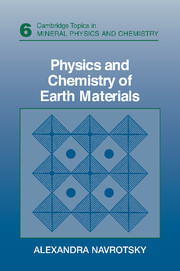Book contents
- Frontmatter
- Contents
- Acknowledgments
- 1 Introduction
- 2 Crystal chemistry
- 3 Experimental methods for studying structure
- 4 Methods for studying thermodynamic properties
- 5 Chemical bonding
- 6 Mineral thermodynamics
- 7 Solid solutions and order–disorder
- 8 Melts, glasses, and amorphous materials
- 9 The interface between mineral physics and materials science
- Index
7 - Solid solutions and order–disorder
Published online by Cambridge University Press: 05 June 2012
- Frontmatter
- Contents
- Acknowledgments
- 1 Introduction
- 2 Crystal chemistry
- 3 Experimental methods for studying structure
- 4 Methods for studying thermodynamic properties
- 5 Chemical bonding
- 6 Mineral thermodynamics
- 7 Solid solutions and order–disorder
- 8 Melts, glasses, and amorphous materials
- 9 The interface between mineral physics and materials science
- Index
Summary
Introduction
Disorder in a solid may arise from several different sources: (1) The periodicity may be broken by displacing atoms from their equilibrium positions in a nonperiodic fashion. These defects can be point defects, single atoms in wrong positions, missing atoms, or impurities; line defects, chains of missing, extra, or misplaced atoms, or dislocations; planar defects, twin planes, or sheets of missing atoms; or three-dimensional or structural disorder or lack of periodicity leading eventually to amorphization. (2) A solid solution or alloy may form by replacing one atom, more or less at random, by another with reasonably similar properties, for example, Mg, Fe substitution in olivines. (3) Substitutional disorder may occur when similar atoms ordered onto crystallographic sites at low temperature are partially or completely randomized at high temperature. This situation creates positional disorder but maintains overall stoichiometry. (4) Nonstoichiometry, namely, deviation from ideal atomic ratios, for example, Fe0.97O instead of FeO, creates another kind of disorder. (5) The orientation of polyhedra (octahedral tilting in perovskites, CO3 orientation in carbonates) may lose long-range order. (6) Magnetic moments or electron spins may become disordered.
These various types of disorder are frequently related. In all cases, the equilibrium degree of disorder increases with increasing temperature because of the balance of energy and entropy.
In many substitutional solid solutions formed at high temperature, the disorder may decrease as temperature is lowered by one or both of two mechanisms: (1) The atoms may order into a superstructure.
- Type
- Chapter
- Information
- Physics and Chemistry of Earth Materials , pp. 332 - 370Publisher: Cambridge University PressPrint publication year: 1994
- 2
- Cited by



